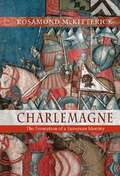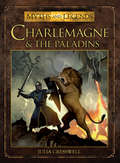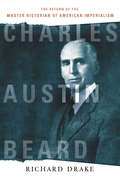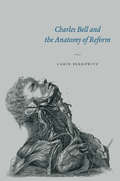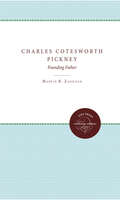- Table View
- List View
Charlemagne
by Johannes FriedWhen the legendary Frankish king and emperor Charlemagne died in 814 he left behind a dominion and a legacy unlike anything seen in Western Europe since the fall of Rome. Johannes Fried paints a compelling portrait of a devout ruler, a violent time, and a unified kingdom that deepens our understanding of the man often called the father of Europe.
Charlemagne: Barbarian and Emperor
by Derek WilsonThe greatest of medieval monarchs, Charles the Great (742-814) towers over every notion we have of national heroes and semi-mythical champions. His military conquests exceeded those of Julius Caesar. He had the sagacity and dedication to public service of a Marcus Aurelius. In ruthlessness, as in dedication to personal culture, he was reminiscent of Augustus. But that is only the beginning. Charlemagne was a phenomenon and phenomena do not die. Later European leaders from Frederick Barbarossa and Charles V to Louis XIV, Napoleon I and Hitler took Charlemagne as their model. His growing mythology inspired the Crusades, fed the concept of chivalry, bolstered absolutist regimes, excited nineteenth-century liberals and emerges today among those who claim Charles the Great as the founder of European unity. Charlemagne is one of the most remarkable figures in European history: only by understanding him in all his complexity can we begin to understand Europe today. Derek Wilson's biography provides such an opportunity.
Charlemagne and the Paladins (Myths and Legends #10)
by Julia Cresswell Miguel CoimbraAmidst the chaos and violence of Europe in the eighth century, Charlemagne became king of the Franks and established a large empire. As Charlemange's power grew, so did the stories attached to his name. This book explores the myths and legends of the great king Charlemagne, from the stories about his mother, Bertha Bigfoot, and his youthful adventures with the thief, Basin, to his fantastical journeys to Jerusalem and Constantinople. It also retells the stories of his most famous knights, the Paladins. These brave warriors were all heroes in their own right, and included many famous names such as Roland, Ogier the Dane, Oliver, Archbishop Turpin, and Guy of Burgundy. Together with his Paladins, Charlemagne established a court to rival Camelot and led the Christian kingdoms of Europe in their ongoing struggles with the armies of the East. Although this great ruler eventually passed away, quietly in his bed, the legends say that he now sits on his golden throne beneath the mountain, waiting until the need of his people calls him forth again.
Charlemagne and the Paladins (Myths and Legends)
by Julia Cresswell Miguel CoimbraAmidst the chaos and violence of Europe in the eighth century, Charlemagne became king of the Franks and established a large empire. As Charlemange's power grew, so did the stories attached to his name. This book explores the myths and legends of the great king Charlemagne, from the stories about his mother, Bertha Bigfoot, and his youthful adventures with the thief, Basin, to his fantastical journeys to Jerusalem and Constantinople. It also retells the stories of his most famous knights, the Paladins. These brave warriors were all heroes in their own right, and included many famous names such as Roland, Ogier the Dane, Oliver, Archbishop Turpin, and Guy of Burgundy. Together with his Paladins, Charlemagne established a court to rival Camelot and led the Christian kingdoms of Europe in their ongoing struggles with the armies of the East. Although this great ruler eventually passed away, quietly in his bed, the legends say that he now sits on his golden throne beneath the mountain, waiting until the need of his people calls him forth again.
Charlemagne's Mustache: And Other Cultural Clusters of a Dark Age (The New Middle Ages)
by P. DuttonCharlemagne's Mustache presents the reader with seven engaging studies, 'thick descriptions', of cultural life and thought in the Carolingian world. The author begins by asking questions. Why did Charlemagne have a mustache and why did hair matter? Why did the king own peacocks and other exotic animals? Why was he writing in bed and could he write at all? How did medieval kings become stars? How were secrets kept and conveyed in the early Middle Ages? And why did early medieval peoples believe in storm and hailmakers? The answers, he found, are often surprising.
Charles: The Heart Of A King
by Catherine MayerThe Sunday Times Top Ten Bestseller'[The book that] made headlines around the world.' Independent He has lived his whole life in the public eye, yet he remains an enigma. He was born to be king, but he aims much higher. A landmark publication, Charles: The Heart of a King reveals Prince Charles in all his complexity: the passionate views that mean he will never be as remote and impartial as his mother; the compulsion to make a difference and the many and startling ways in which the heir to the throne of the United Kingdom and fifteen other realms has already made his mark. The book offers fresh and fascinating insights into the first marriage that did so much to define him and an assessment of his relationship with the woman he calls, with unintended accuracy, his 'dearest wife': Camilla. We see Charles as a father and a friend, a serious figure and a joker. Life at court turns out to be full of hidden dangers and unexpected comedy. Poignant, funny and often surprising, the first significant study of the Prince in over a decade reveals a man in sight of happiness yet still driven by anguish and a remarkable belief system, a charitable entrepreneur, activist, agitator and avatar of the Establishment who just as often tilts against it. Based on multiple interviews with his friends and courtiers, palace insiders and critics, and access to Charles himself during research lasting more than a year, this biography explores the Prince’s philanthropy and his compulsive interventionism, his faith, his political leanings and the philosophy that means when he seeks harmony he sometimes creates controversy. Gripping, at times astonishing, often laugh-out-loud, this is a royal biography unlike any other.
Charles: The Misunderstood Prince
by Sally Bedell SmithThe FIRST MAJOR BIOGRAPHY to seek out the real Charles, from the New York Times bestselling author of Elizabeth the Queen. PERFECT for fans of THE CROWN.'For all we know about Prince Charles, there is so much we didn't know - until now.' Tom Brokaw ----------------------------- Drawing on extensive access to the Royal Family's inner circle, Sally Bedell Smith delivers unprecedented insights into Prince Charles, a man who possesses a fiercely independent spirit, and yet has spent his life in waiting for the ultimate role. Beginning with his lonely childhood, Smith details his intellectual quests, his entrepreneurial pursuits, and his love affairs, from the tragedy of his marriage to Diana to his eventual reunion with Camilla, as well as his relationship with the next generation of royals, including Will, Kate, Harry, and his beloved grandchildren. As this sweeping biography shows, Prince Charles is more complicated and compelling than we knew, until now.'Brilliant, startling. The royal biography everyone's talking about' Daily Mail
Charles Austin Beard: The Return of the Master Historian of American Imperialism
by Richard DrakeRichard Drake presents a new interpretation of Charles Austin Beard's life and work. The foremost American historian and a leading public intellectual in the first half of the twentieth century, Beard participated actively in the debates about American politics and foreign policy surrounding the two world wars. Drake takes this famous man's life and rewrites his intellectual biography by placing the European dimension of Beard's thought at the center. This radical change of critical focus allows Drake to correct previous biographers' oversights and, in Charles Austin Beard, present a far more nuanced appreciation for Beard's life than we have read before.Drake proposes a restoration of Beard's professional reputation, which he lost in large part because of his extremely unpopular opposition to America's intervention in World War II. Drake analyzes the stages of Beard's development as a historian and critic: his role as an intellectual leader in the Progressive movement, the support that he gave to the cause of American intervention in World War I, and his subsequent revisionist repudiation of Wilsonian ideals and embrace of non-interventionism in the lead-up to World War II. Many of his dire predictions about the inevitable consequences of pre-World War II American foreign policy have come to pass. Drake shows that, as Americans tally the ruinous costs—both financial and moral—of nation-building and informal empire, the life and work of this prophet of history merit a thorough reexamination.
Charles The Bald: Court And Kingdom: Papers Based On A Colloquium Held In London In April 1979 (The Medieval World #Vol. 2)
by Janet L. NelsonThis important and long-awaited study is the first full-scale biography of Charlemagne's grandson, King of the West Franks from 843 to 877, and Emperor from 875. Posterity has not been kind to Charles or his age, seeing him as a fatally weak ruler in decadent times, threatened by Viking invaders and overmighty subjects. Janet Nelson, however, reveals an able and resourceful ruler who, under challenging conditions, maintained and enhanced royal authority, and held together the kingdom that, outlasting the Carolingians themselves, in due course became France.
Charles The Bald (The Medieval World)
by Janet L. NelsonThis important and long-awaited study is the first full-scale biography of Charlemagne's grandson, King of the West Franks from 843 to 877, and Emperor from 875. Posterity has not been kind to Charles or his age, seeing him as a fatally weak ruler in decadent times, threatened by Viking invaders and overmighty subjects. Janet Nelson, however, reveals an able and resourceful ruler who, under challenging conditions, maintained and enhanced royal authority, and held together the kingdom that, outlasting the Carolingians themselves, in due course became France.
Charles Beard and the Constitution: A Critical Analysis (PDF)
by Robert Eldon Brown"One could almost use the word momentous, or the word epoch-making though epoch-ending might be more to the point ... I don't see how anyone henceforth can repeat the old cliches which Beard put into circulation forty years ago."—Frederick B. Tolles, Swarthmore College.“American historians, particularly those who have given lectures or written books based on the Beard thesis, ignore Brown’s book at their peril.”—American Historical Review.Originally published in 1956.The Princeton Legacy Library uses the latest print-on-demand technology to again make available previously out-of-print books from the distinguished backlist of Princeton University Press. These editions preserve the original texts of these important books while presenting them in durable paperback and hardcover editions. The goal of the Princeton Legacy Library is to vastly increase access to the rich scholarly heritage found in the thousands of books published by Princeton University Press since its founding in 1905.
Charles Bell and the Anatomy of Reform
by Carin BerkowitzSir Charles Bell (1774–1842) was a medical reformer in a great age of reform—an occasional and reluctant vivisectionist, a theistic popularizer of natural science, a Fellow of the Royal Society, a surgeon, an artist, and a teacher. He was among the last of a generation of medical men who strove to fashion a particularly British science of medicine; who formed their careers, their research, and their publications through the private classrooms of nineteenth-century London; and whose politics were shaped by the exigencies of developing a living through patronage in a time when careers in medical science simply did not exist. A decade after Bell’s death, that world was gone, replaced by professionalism, standardized education, and regular career paths. In Charles Bell and the Anatomy of Reform, Carin Berkowitz takes readers into Bell’s world, helping us understand the life of medicine before the modern separation of classroom, laboratory, and clinic. Through Bell’s story, we witness the age when modern medical science, with its practical universities, set curricula, and medical professionals, was born.
Charles Bell and the Anatomy of Reform
by Carin BerkowitzSir Charles Bell (1774–1842) was a medical reformer in a great age of reform—an occasional and reluctant vivisectionist, a theistic popularizer of natural science, a Fellow of the Royal Society, a surgeon, an artist, and a teacher. He was among the last of a generation of medical men who strove to fashion a particularly British science of medicine; who formed their careers, their research, and their publications through the private classrooms of nineteenth-century London; and whose politics were shaped by the exigencies of developing a living through patronage in a time when careers in medical science simply did not exist. A decade after Bell’s death, that world was gone, replaced by professionalism, standardized education, and regular career paths. In Charles Bell and the Anatomy of Reform, Carin Berkowitz takes readers into Bell’s world, helping us understand the life of medicine before the modern separation of classroom, laboratory, and clinic. Through Bell’s story, we witness the age when modern medical science, with its practical universities, set curricula, and medical professionals, was born.
Charles Bell and the Anatomy of Reform
by Carin BerkowitzSir Charles Bell (1774–1842) was a medical reformer in a great age of reform—an occasional and reluctant vivisectionist, a theistic popularizer of natural science, a Fellow of the Royal Society, a surgeon, an artist, and a teacher. He was among the last of a generation of medical men who strove to fashion a particularly British science of medicine; who formed their careers, their research, and their publications through the private classrooms of nineteenth-century London; and whose politics were shaped by the exigencies of developing a living through patronage in a time when careers in medical science simply did not exist. A decade after Bell’s death, that world was gone, replaced by professionalism, standardized education, and regular career paths. In Charles Bell and the Anatomy of Reform, Carin Berkowitz takes readers into Bell’s world, helping us understand the life of medicine before the modern separation of classroom, laboratory, and clinic. Through Bell’s story, we witness the age when modern medical science, with its practical universities, set curricula, and medical professionals, was born.
Charles Bell and the Anatomy of Reform
by Carin BerkowitzSir Charles Bell (1774–1842) was a medical reformer in a great age of reform—an occasional and reluctant vivisectionist, a theistic popularizer of natural science, a Fellow of the Royal Society, a surgeon, an artist, and a teacher. He was among the last of a generation of medical men who strove to fashion a particularly British science of medicine; who formed their careers, their research, and their publications through the private classrooms of nineteenth-century London; and whose politics were shaped by the exigencies of developing a living through patronage in a time when careers in medical science simply did not exist. A decade after Bell’s death, that world was gone, replaced by professionalism, standardized education, and regular career paths. In Charles Bell and the Anatomy of Reform, Carin Berkowitz takes readers into Bell’s world, helping us understand the life of medicine before the modern separation of classroom, laboratory, and clinic. Through Bell’s story, we witness the age when modern medical science, with its practical universities, set curricula, and medical professionals, was born.
Charles Bonnet, Analytical Essay on the Faculties of the Soul
by Stephen GaukrogerIn the course of the eighteenth century, understanding human cognitive life came to be construed as something to be explored in terms of the physiology of the sensory organs, the nerves, and the brain: a form of naturalization that effectively moved cognition out of the realm of philosophy as it had traditionally been understood. Bonnet's Analytical Essay on the Faculties of the Soul was at the forefront of these developments, and this is its first English translation. Drawing on his earlier work in natural history—he was the leading entomologist of his era—he approaches problems of the nature of the mind via the physiology and anatomy of the brain and sensory systems. His approach is one of 'reverse engineering', starting from an organic statue without faculties, and investigating how it would need to be modified to produce a human being. Bonnet takes up a position that cuts across the standard understanding of the period as a clash between materialism and dualism. While his approach was rigorously naturalistic and physiological, this did not lead him to reject the notion of a soul. Instead, he argues that, in order to make sense of their sensory abilities, we need to attribute a soul to animals as well as human beings. At the same time, he argues that if personal immortality is to be possible, it can be conceived along the lines of insect metamorphosis, which shows how different biological forms can harbour a single identity.
Charles Bonnet, Analytical Essay on the Faculties of the Soul
by Stephen GaukrogerIn the course of the eighteenth century, understanding human cognitive life came to be construed as something to be explored in terms of the physiology of the sensory organs, the nerves, and the brain: a form of naturalization that effectively moved cognition out of the realm of philosophy as it had traditionally been understood. Bonnet's Analytical Essay on the Faculties of the Soul was at the forefront of these developments, and this is its first English translation. Drawing on his earlier work in natural history—he was the leading entomologist of his era—he approaches problems of the nature of the mind via the physiology and anatomy of the brain and sensory systems. His approach is one of 'reverse engineering', starting from an organic statue without faculties, and investigating how it would need to be modified to produce a human being. Bonnet takes up a position that cuts across the standard understanding of the period as a clash between materialism and dualism. While his approach was rigorously naturalistic and physiological, this did not lead him to reject the notion of a soul. Instead, he argues that, in order to make sense of their sensory abilities, we need to attribute a soul to animals as well as human beings. At the same time, he argues that if personal immortality is to be possible, it can be conceived along the lines of insect metamorphosis, which shows how different biological forms can harbour a single identity.
Charles Bonnet and the Order of the Known (Studies in the History of Modern Science #11)
by L. AndersonCharles Bonnet began his career as a naturalist, from an early age establishing a reputation as a careful observer. It is for those youthful observations, as well as for some suggestive speculations proposed relative to this field, that he is best remembered in English-speaking countries: regarding the taxonomic de mands of natural history he refurbished the idea of a chain of beings; regarding the question of generation he marshaled evidence in support of preforma tion theory; and regarding the analysis of the physiology of the nervous system he advanced a theory that individual nerve fibers receive and retain specific sensations. Following his loss of eyesight in his mid-twenties Bonnet entered a more reflective period, turning to philosophy and pondering the nature of human understanding - considerations he had formerly disdained, but that now seemed a natural outgrowth of his reflections on nature. This essay focuses on the philosophical and psychological works of the later period, the period in which he wrote all his major books. By giving these writings a broader exposure it has been one of my hopes that Bonnet's audience would also be broadened, releasing him, so to speak, from the charge of historians of science so that he might fmd his way, in general books on the "Enlightenment", from scattered footnotes into the texts themselves.
Charles Borromeo: Selected Orations, Homilies and Writings
by Charles Borromeo John R. Cihak Ansgar SantogrossiCharles Borromeo (1538-1584) became the driving force of reform within the Catholic Church in the wake of the Council of Trent following the Protestant Reformation and the primary reason Trent's dramatic reforms were successful. His remarkable accomplishments in Milan as Archbishop became the model of reform for the rest of Western Europe. Change is never easy, but St. Charles' approach – deeply biblical, personal, practical and centered on Christ – offers a road map of reform, even for today. Now for the first time in over 400 years a significant selection of his works appears in the English language.Chapter 1 offers three orations that St Charles gave as Archbishop of Milan to the other Bishops. These texts were among those that Pope Paul VI sent out to the Bishops of the world in 1963 during Vatican II. Chapter 2 contains a selection of homilies on the Eucharist and is followed by a collection of texts that treat the reform of the clergy. The final chapter presents Borromeo's efforts at mobilizing the laity in their own reform.This translation is intended to be faithful to Borromeo's Latin or Italian texts rendered into contemporary English.
Charles Borromeo: Selected Orations, Homilies and Writings
by Charles Borromeo Fr John R. CihakCharles Borromeo (1538-1584) became the driving force of reform within the Catholic Church in the wake of the Council of Trent following the Protestant Reformation and the primary reason Trent's dramatic reforms were successful. His remarkable accomplishments in Milan as Archbishop became the model of reform for the rest of Western Europe. Change is never easy, but St. Charles' approach – deeply biblical, personal, practical and centered on Christ – offers a road map of reform, even for today. Now for the first time in over 400 years a significant selection of his works appears in the English language.Chapter 1 offers three orations that St Charles gave as Archbishop of Milan to the other Bishops. These texts were among those that Pope Paul VI sent out to the Bishops of the world in 1963 during Vatican II. Chapter 2 contains a selection of homilies on the Eucharist and is followed by a collection of texts that treat the reform of the clergy. The final chapter presents Borromeo's efforts at mobilizing the laity in their own reform.This translation is intended to be faithful to Borromeo's Latin or Italian texts rendered into contemporary English.
Charles & Camilla: Portrait Of A Love Affair
by Gyles BrandrethThis is the definitive account of one of the most extraordinary stories of our time. Gyles Brandreth, acclaimed biographer of the Queen and Prince Philip, presents a unique portrait of their son, Charles, Prince of Wales, and of the one 'non-negotiable' love of his life, Camilla Shand, now Duchess of Cornwall.What are Charles and Camilla really like? What is their heritage? What has made them the way they are? This is both a revealing portrait of two unusual individuals and a family saga like no other, told with unrivalled authority and insight - and humour - by a best-selling writer who has met all the key characters in the drama: Charles, Camilla, Diana, their children, their families and their friends.
Charles Cotesworth Pinckney: Founding Father (Published by the Omohundro Institute of Early American History and Culture and the University of North Carolina Press)
by Marvin R. ZahniserPinckney's lifetime as a leading member of the southern oligarchy is important to an understanding of that group's assumptions about itself, its aspirations, and its exacting standards of public and private conduct for its leaders. It also provides insight into the development of the Federalist and Republican parties in the South and vividly demonstrates the effects of the national party system on the old regime of state politics in South Carolina.Originally published in 1967.A UNC Press Enduring Edition -- UNC Press Enduring Editions use the latest in digital technology to make available again books from our distinguished backlist that were previously out of print. These editions are published unaltered from the original, and are presented in affordable paperback formats, bringing readers both historical and cultural value.
Charles Crichton (British Film-Makers)
by Quentin FalkCharles Crichton is perhaps best remembered as the director of the unlikely blockbuster hit A Fish Called Wanda, made when he was seventy-seven years old. But the most significant part of his career was spent at Ealing Studios in the 1940s and 1950s, working on such beloved comedies as Hue and Cry, The Lavender Hill Mob and The Titfield Thunderbolt. Nonetheless, as this pioneering study of Crichton’s work reveals, his filmmaking skills extended way beyond comedy to wartime dramas and film noir, and his adaptability served him well when he made the transition into primetime television, working on popular shows such as The Avengers, Space: 1999 and The Adventures of Black Beauty. Featuring first-hand testimony from colleagues ranging from Dame Judi Dench and Petula Clark to John Cleese and Sir Michael Palin, this riveting account of Crichton’s fascinating life in film will appeal to film scholars and general readers alike.
Charles Crichton (British Film-Makers)
by Quentin FalkCharles Crichton is perhaps best remembered as the director of the unlikely blockbuster hit A Fish Called Wanda, made when he was seventy-seven years old. But the most significant part of his career was spent at Ealing Studios in the 1940s and 1950s, working on such beloved comedies as Hue and Cry, The Lavender Hill Mob and The Titfield Thunderbolt. Nonetheless, as this pioneering study of Crichton’s work reveals, his filmmaking skills extended way beyond comedy to wartime dramas and film noir, and his adaptability served him well when he made the transition into primetime television, working on popular shows such as The Avengers, Space: 1999 and The Adventures of Black Beauty. Featuring first-hand testimony from colleagues ranging from Dame Judi Dench and Petula Clark to John Cleese and Sir Michael Palin, this riveting account of Crichton’s fascinating life in film will appeal to film scholars and general readers alike.

